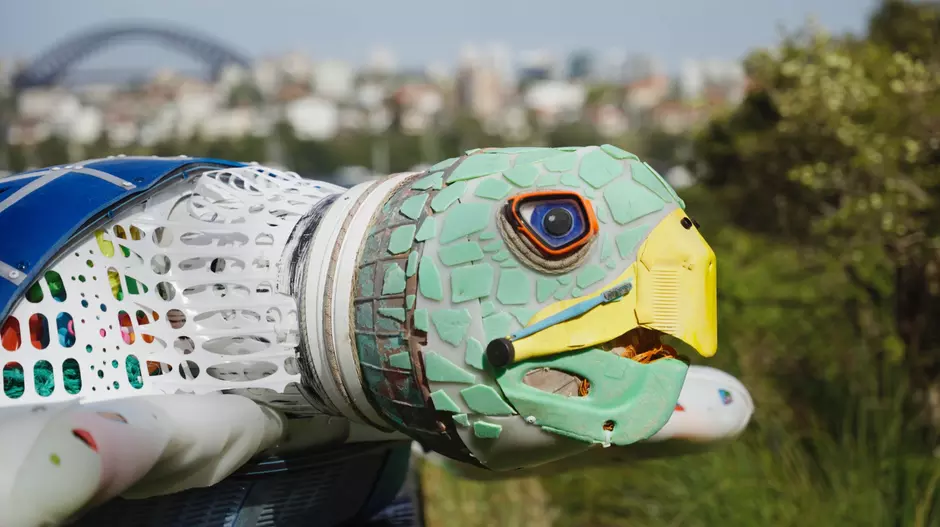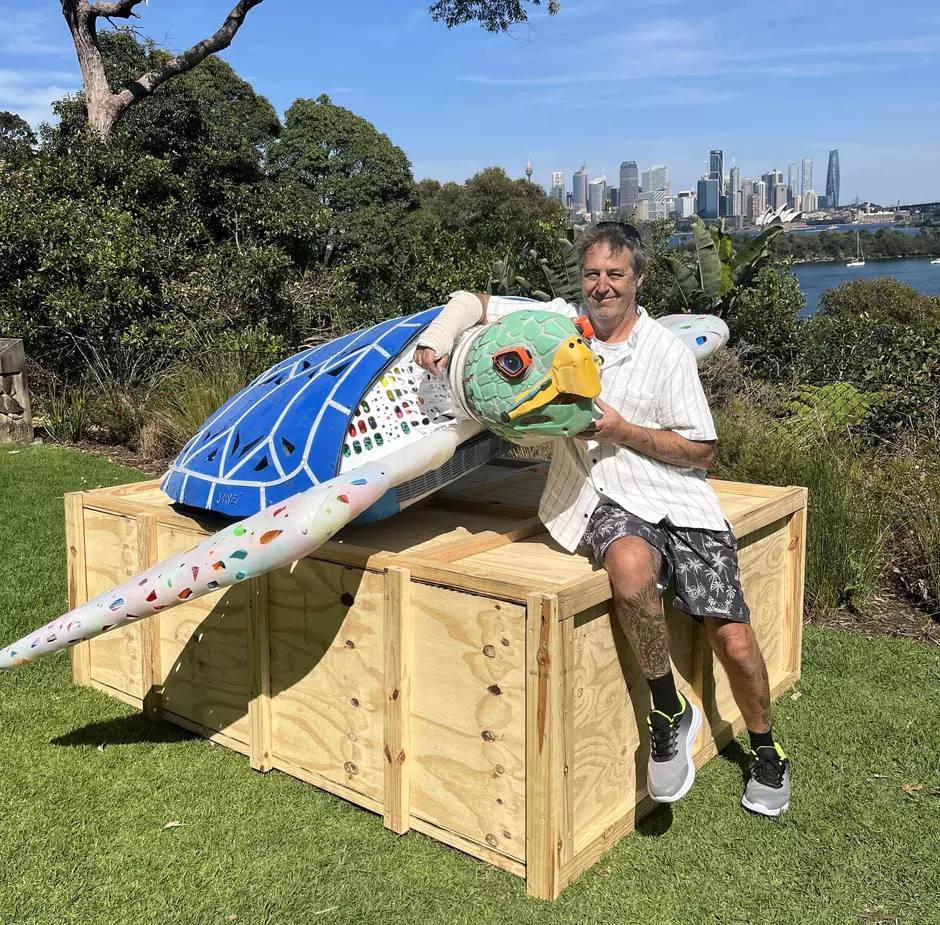Sea turtle sculpture made entirely from waste found on Australian beaches. Australian artist David Day scoured beaches to find ocean debris for this brightly coloured turtle that will be on display at Taronga Zoo, Sydney, for six weeks.
Warmer months are peak turtle rescue season at Taronga Wildlife Hospital. Every year around 40 marine turtles are admitted to the hospital. Veolia has been a long-term partner supporting the Taronga Conservation Society Australia’s conservation efforts and the rehabilitation, release and satellite tracking of turtles.
A giant, brightly coloured marine turtle sculpture made entirely from plastic waste found on Australian beaches is set to become Taronga Zoo’s newest resident, thanks to an artwork commissioned by Veolia ANZ, the Zoo’s waste management partner. The turtle – which will be named by the public – will call the zoo home for six weeks, throughout the NSW spring school holidays.
The installation will show guests of all ages the impact waste has on the marine environment, highlighting the actions every Australian can take to save our endangered marine turtles, and showcase the beauty in transforming waste into art.
Veolia ANZ commissioned the turtle sculpture to illustrate the impact waste has on our oceans and to highlight Taronga Zoo’s Turtle Rehabilitation Program that it sponsors.
"We see our sponsorship of the turtle rehabilitation program and this artwork as genuinely meaningful contributions that go to the heart of Veolia’s core mission of ecological transformation, which aims to depollute, decarbonise and regenerate our natural environment" said Veolia ANZ CEO Richard Kirkman
“How we dispose of our waste, especially at our beaches, has enormous implications for all three of these goals. Every individual action, when combined with the recycling expertise of companies like Veolia, has the power to create a lasting environmental impact and save our endangered wildlife.
Every business, government and personal decision plays a vital role. None of us get a free pass on playing our part. Together we can keep our beaches clean and preserve these turtles and many other magnificent creatures for future generations ― which is what makes Taronga Zoo, a protector of the animal kingdom, the perfect venue for this sculpture.”
It’s an important message for sculptor David Day, who found making the turtle produced a mixture of emotions, especially when it was so easy to find the raw materials on the beach.
“On one hand, I got deeply involved in the creative process of making it as beautiful as I could with the plastic I found on the beach, but at the same time, I knew that the plastic was harming the environment and is deadly to turtles and other wildlife,” Day said.
“And that’s the contradiction. While I am proud of the sculpture, and happy that I have a creative avenue to remove waste from our beaches, part of me wishes it wasn’t so easy to find the raw material and build it in the first place. My hope is that one day this turtle will be a relic of the past, more a curiosity of the way things were, not the way things are,” Day said.
Australians are extraordinarily fortunate to be able to see living marine turtles in the wild. Worldwide, there are only seven species of ocean-going turtles – six of these live in Australian waters. Taronga Conservation Society Australia’s research shows many live along the busy coastlines and harbours close to where we live, particularly during warmer months when turtles move south on warm ocean currents.
"Every year, around 40 marine turtles are admitted to the Taronga Wildlife Hospital in Sydney, dangerously ill after ingesting plastic, becoming entangled in fishing line and hooks, or being struck by boats and jet skis. It requires months of persistent and patient care by the dedicated veterinary team to restore them back to full health and eventually return them to the ocean, and sadly not all turtles can be saved”, said Nick Boyle, Executive Director at Taronga Zoo Sydney.
"From plastic ingestion to propeller strikes, these are injuries caused by human activity. We all have the responsibility to dispose of litter properly in our environments and reduce our plastic consumption – it could save the life of a marine turtle.
“It’s so important that we share this message loud and clear for all to hear – we all have a role to play in securing a future for these ancient marine animals”.
Veolia has been a long-term partner of Taronga Conservation Society Australia, supporting conservation efforts in the rehabilitation, release and tracking of marine turtles. The turtle manifests Veolia’s mission of ecological transformation, which is all about depolluting, decarbonising and regenerating the world. This ambition has been realised with increased investment directed to Australia in resource recovery, water and energy infrastructure as part of a global GreenUp strategy.
"Taronga is committed to diverting 90% of operational landfill, and by managing 23 distinctive waste streams, one tonne of soft plastics were recycled last year. Taronga has banned single-use plastics onsite such as balloons, individual sauce sachets and all plastic beverage containers."In Australia during 2024, Veolia ANZ’s material recovery facilities sorted and separated 93,000 tonnes of paper, cardboard, metal and plastic to be sent off for recycling. All of Veolia’s material recovery facilities have installed solar panels and are powered by renewable energy.
The turtle will be on display from Thursday, September 26 to Friday, October 31. Find out more about the sculpture and submit a name when you visit our web page about the turtle sculpture, below.
Contact Us For All Media Enquiries
Manager Public Relations
Alvin Stone
Tel: 0418 617 366
Email: [email protected]
Head of Communications and Public Policy
Lena Bax
Tel: 0405 242 955
Email: [email protected]





